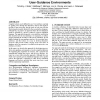Free Online Productivity Tools
i2Speak
i2Symbol
i2OCR
iTex2Img
iWeb2Print
iWeb2Shot
i2Type
iPdf2Split
iPdf2Merge
i2Bopomofo
i2Arabic
i2Style
i2Image
i2PDF
iLatex2Rtf
Sci2ools
SIGSOFT
2001
ACM
2001
ACM
An architecture for flexible, evolvable process-driven user-guidance environments
Complex toolsets can be difficult to use. User interfaces can help by guiding users through the alternative choices that might be possible at any given time, but this tends to lock users into the fixed interaction models dictated by the user-interface designers. Alternatively, we propose an approach where the tool utilization model is specified by a process, written in a process definition language. Our approach incorporates a user-interface specification that describes how the user-interface is to respond to, or reflect, progress through the execution of the process definition. By not tightly binding the user-guidance process, the associated userinterfaces, and the toolset, it is easy to develop alternative processes that provide widely varying levels and styles of guidance and to be responsive to evolution in the processes, user interfaces, or toolset. In this paper, we describe this approach for developing processdriven user-guidance environments, a loosely coupled architecture for...
Process Definition Language | Process Definition Languages | SIGSOFT 2001 | Software Engineering | Specific Process Definition |
| Added | 20 Nov 2009 |
| Updated | 20 Nov 2009 |
| Type | Conference |
| Year | 2001 |
| Where | SIGSOFT |
| Authors | Timothy J. Sliski, Matthew P. Billmers, Lori A. Clarke, Leon J. Osterweil |
Comments (0)

